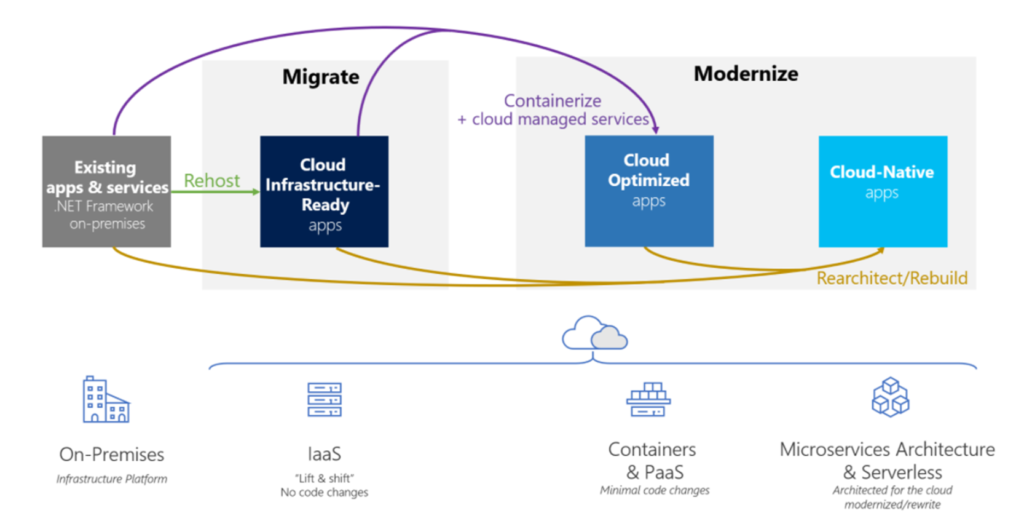Customer Experience
Customer experience is more important than ever. The Forrester investigation (“Outside In”) put it this way:
“More than any other factor, customer experiences determine whether companies thrive and profit, or struggle and fade”
This means that customer experience is a strong determining factor in growing and being profitable, or fighting and disappearing as a company. The word “customer” can also be viewed more broadly in this modern world. It is not only about your end customers, but also about your partners, internal employees, and even your developers.
By modernizing .Net apps with Microsoft App Service or Azure SQL Database, you enable your company to significantly improve the customer experience. This leads to lightning-fast innovation, elastic scalability, and an overall better performance. If you do not get the applications to the user quickly enough, chances are that the market you wanted to approach is already setting new requirements and you will be late, no matter how well your application was designed and developed.
The need for continuous business innovation pushes developers and operations teams to their limits. One way to achieve the flexibility and scalability in this world of continuous innovation is to modernize your (.Net) applications with technologies such as containers and specific cloud optimization principles, which we will discuss below.
Your personal journey to the
The good news is, if you decide to move your .Net applications or services to the cloud, you don’t necessarily have to rebuild them. Redesigning an application using an advanced approach (eg Microservices) is not always an option due to cost or time constraints. To optimize the cost effectiveness of your cloud migration strategy, it is important to properly map out the business requirements of your applications and make the right choices:
- Which applications require a complete transformation or new architecture?
- Which applications should be only partially modernized?
- Which applications can be brought to the cloud without any code changes?
There is no one-size-fits-all strategy for migrating applications to the cloud. The strategy will depend on the needs and priorities of your organization, as well as the type of applications to be migrated. In many cases, a phased approach based on your (future) business needs, user needs, and market requirements is the best strategy to bring your applications to the cloud.
The migration of an existing, unwieldy application to the cloud is less straightforward than building a new app in a cloud native environment. However, here too you can get a lot of benefits from a cloud migration with minimal effort. By migrating the application “as is” to a virtual machine or app service, for example, you can quickly enjoy the benefits of the cloud without setting up a gigantic project.
The image below illustrates the different possible ways to the cloud. We can help you make the right choices, as well as implement your (.Net) application innovation process.

Each approach has different advantages and reasons for use. You can choose one approach or combine several. Even within your organization, each application is not limited to a single approach or maturity level. We distinguish three maturity levels when it comes to .Net modernization:
- Applications ready for a cloud infrastructure
The on-premise applications are migrated to an “Infrastructure as a Service” platform, or IAAS platform for short. This approach is known as the “Lift & Shift”: Applications retain their exact structure and properties, but at the same time also benefit from the scalability, security and global availability of the Azure Cloud. - Cloud modernized applications
It uses modern technologies such as “containers” and other cloud managed services without requiring a complete change of the application architecture. This improves the flexibility of the applications and DevOps processes can be optimized. The containers are brought together on an IaaS or Paas platform in combination with cloud managed services such as databases, cache as a service, monitoring and continuous integration / deployment (CI / CD) pipelines. - Cloud Native Applications
This should be the ultimate goal, yet this often only applies to a limited number of applications. At this level, PaaS services are used to migrate applications. In doing so, cloud native application technologies and microservices are always used to evolve the architecture to the most flexible, scalable, and future-oriented application level. This type of modernization usually requires an in-depth adjustment of the application, including writing new code, which it is not always an option.
The image below shows the different maturity levels, as well as the associated requirements, with a focus on .Net applications:

The day-to-day operation of many companies is still done on “old-fashioned” .Net applications. In these special times, this can create a huge barrier to customer satisfaction, flexibility, scalability and security.
Spikes would like to look ahead with you to the modernization of these applications at the rhythm of your organization, via various routes, tailored to your application landscape, business needs and future vision. As a Microsoft Gold & Managed Partner, we can always count on Microsoft’s support for the migration or modernization of .Net applications.
Based on our Application Modernization Solution Assessment, we map out the application landscape of your organization. This makes it clear what costs are associated with a cloud migration, how to get started and which applications require priority.
Would you like more information about this assessment and how it can help you find the right migration strategy? Click the button below for more information.
